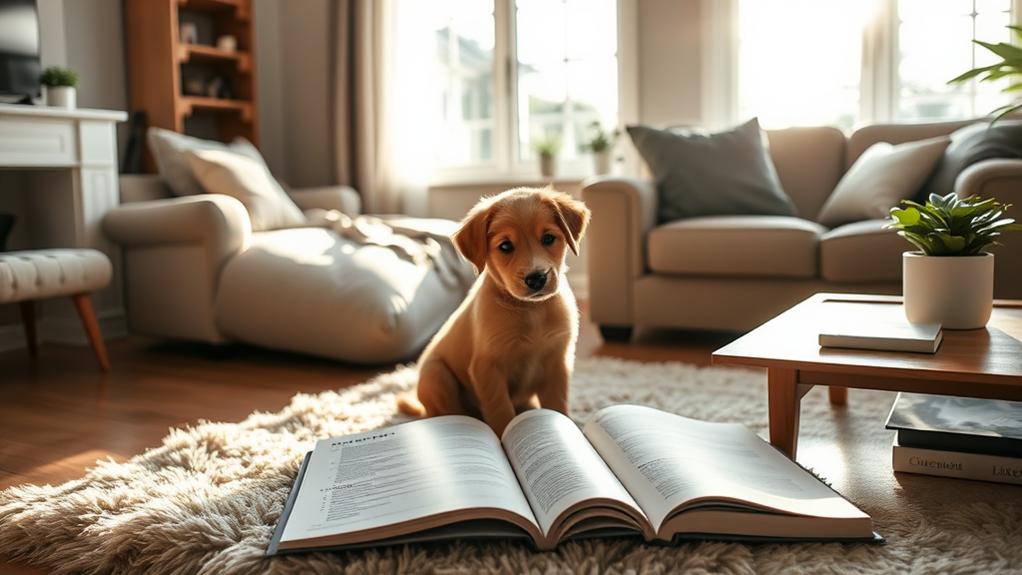Imagine you've just adopted a spirited puppy named Max, who seems to think your living room is his personal bathroom. You might feel overwhelmed, but following this step-by-step housebreaking guide can change that. By implementing structured routines and positive reinforcement, you not only set the stage for success but also foster a deeper connection with your new companion. However, without the right approach, you could be setting yourself up for frustration. So, what are the essential strategies that can transform this chaotic situation into a positive experience for both of you?
Importance of Housebreaking
Housebreaking is vital for both you and your pet, as it lays the foundation for a harmonious living environment. When your dog learns where and when to relieve itself, you'll avoid messes and odors in your home, making it a more pleasant place for you and your family.
Furthermore, a well-housebroken dog is often happier and healthier, feeling secure in its routines and surroundings.
By investing time in housebreaking, you're also nurturing trust between you and your pet. Your dog will learn to understand your cues and expectations, which strengthens your bond. This process can reduce anxiety for both of you, as your pet knows what's expected and you can enjoy a stress-free living space.
Additionally, housebreaking is essential for your dog's socialization. A well-trained pet can join you in various environments without the fear of accidents, allowing you to enjoy outings, visits, and gatherings without worry.
Ultimately, successful housebreaking sets the stage for a well-mannered companion, making your life easier and enhancing your pet's overall quality of life.
Understanding Puppy Behavior
Understanding your puppy's behavior is essential to successful housebreaking and overall training. Puppies communicate through their actions, and recognizing these signals can help you respond appropriately. For instance, if your puppy circles or sniffs around, it may indicate the need to relieve itself. Pay close attention to these cues, and don't hesitate to take your puppy outside immediately.
Puppies thrive on routine. Establishing a consistent schedule for feeding, playtime, and bathroom breaks helps your puppy understand when and where it's expected to go. Remember, puppies have small bladders, so frequent potty breaks are vital, especially after meals or naps.
Positive reinforcement is significant. When your puppy eliminates outside, reward it with praise or treats. This reinforces good behavior and encourages your puppy to repeat it. Conversely, avoid scolding your puppy for accidents inside. Instead, focus on redirecting and teaching them the correct behavior.
Lastly, be patient. Housebreaking takes time, and every puppy learns at its own pace. Understanding your puppy's unique personality and behavior will make the process smoother, ensuring a happy, well-adjusted dog.
Essential Tools for Success
To successfully housebreak your puppy, having the right tools on hand can make all the difference. First, invest in high-quality puppy pads. These absorbent pads are vital for preventing accidents indoors and help your puppy learn where it's appropriate to go.
Next, consider a crate. A crate provides a safe space for your puppy and aids in establishing a routine, as dogs naturally avoid soiling their sleeping area.
You'll also want to have a reliable enzymatic cleaner. Accidents happen, and using the right cleaner will eliminate odors that might encourage your puppy to return to the same spot.
A leash is another must-have. It helps you control your puppy during outdoor bathroom breaks, ensuring they focus on doing their business rather than getting distracted.
Additionally, treat rewards are significant. Positive reinforcement encourages your puppy to associate outdoor elimination with praise and treats.
Finally, a consistent schedule is your best tool. Set regular feeding times and bathroom breaks to create a routine that your puppy can learn to follow.
With these essential tools, you'll set the stage for successful housebreaking and a happy, well-adjusted puppy.
Common Housebreaking Mistakes
Even with the right tools, mistakes can easily lead to setbacks in your housebreaking efforts. One common mistake is inconsistency in your schedule. Dogs thrive on routine, so if you're erratic with potty breaks, your pup will struggle to understand when and where it's acceptable to go.
Another frequent error isn't rewarding your dog immediately after they go outside. If you wait too long, they won't connect the dots between the behavior and the reward. Timing is everything, so be quick with your praise or treats.
Some owners also underestimate the importance of supervision. If you allow your dog to roam freely inside the house, they might take advantage of the opportunity to relieve themselves.
Keep a close eye on your dog and confine them to a smaller area when you can't supervise.
Tips for Consistency and Patience
Establishing a consistent routine is key to successful housebreaking, and it can make a world of difference for both you and your pup. Set specific times for feeding, bathroom breaks, and playtime. This helps your dog learn when to expect these activities, reinforcing good habits.
Be patient. Housebreaking isn't an overnight process, and every pup learns at their own pace. Celebrate small victories and don't get frustrated by setbacks. If accidents happen, avoid scolding your dog; instead, clean up promptly and calmly. This teaches them that accidents aren't a big deal, which can reduce anxiety.
Use positive reinforcement to encourage desired behaviors. Reward your dog immediately after they go outside, using treats or praise. This connection helps them understand that going outside is the right choice.
Stay vigilant. Take your pup outside regularly, especially after meals, naps, or playtime. Watch for signs that they need to go, like sniffing or circling, and act quickly.
Lastly, maintain a calm demeanor. Your dog can sense your emotions. If you remain patient and consistent, your pup will thrive, and housebreaking will become a smoother experience for both of you.
Conclusion
By following this step-by-step housebreaking guide, you're not just teaching your puppy where to go; you're building trust and communication. Remember, patience is key—every mistake is a learning opportunity for both of you. Embrace the journey, and you'll discover that a well-trained puppy isn't just a goal; it's a pathway to a deeper bond. In nurturing their behavior, you'll also nurture your own growth as a pet owner, creating a happier home for everyone.



